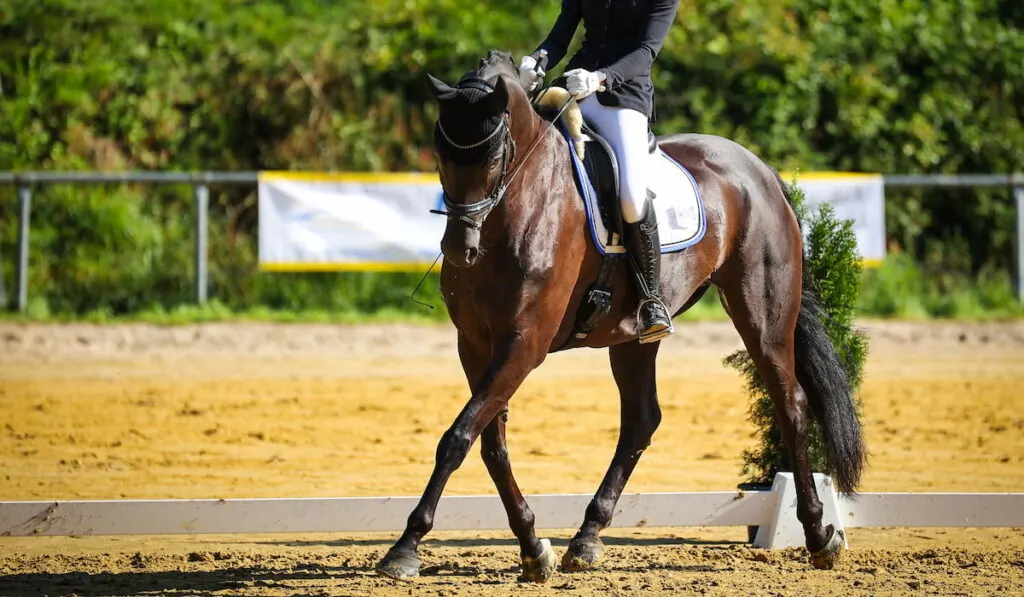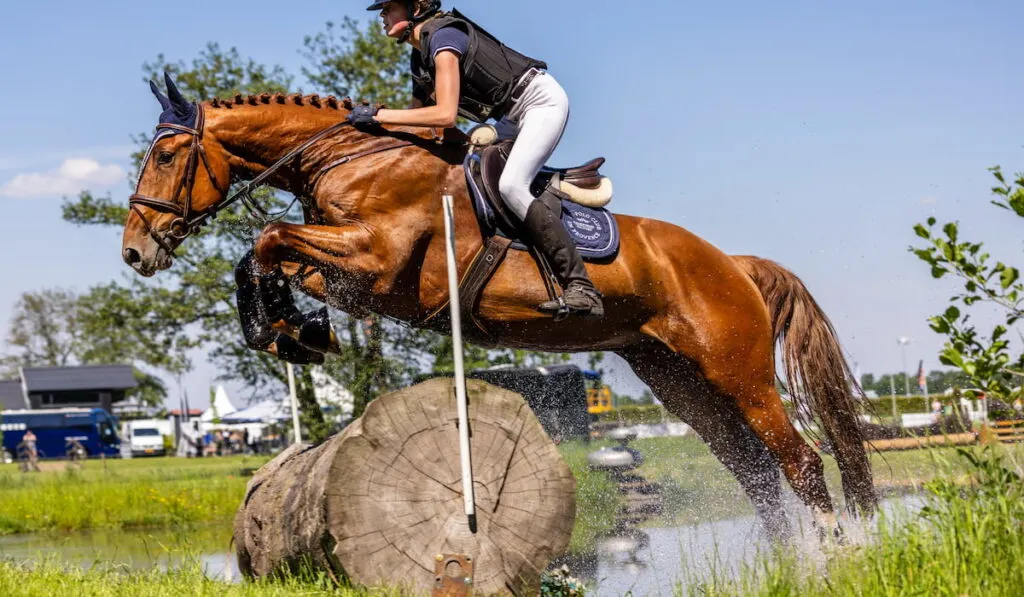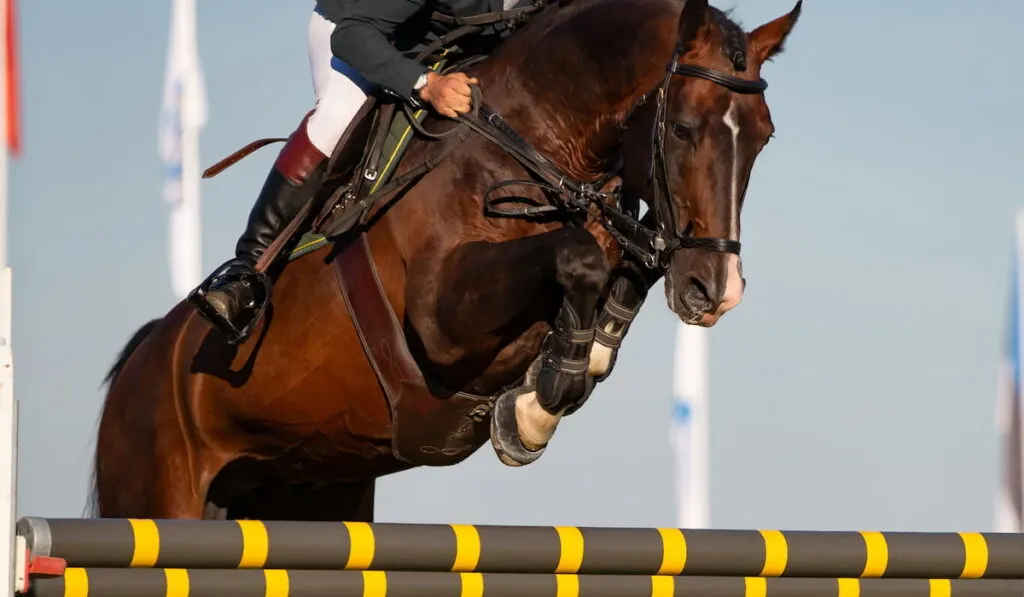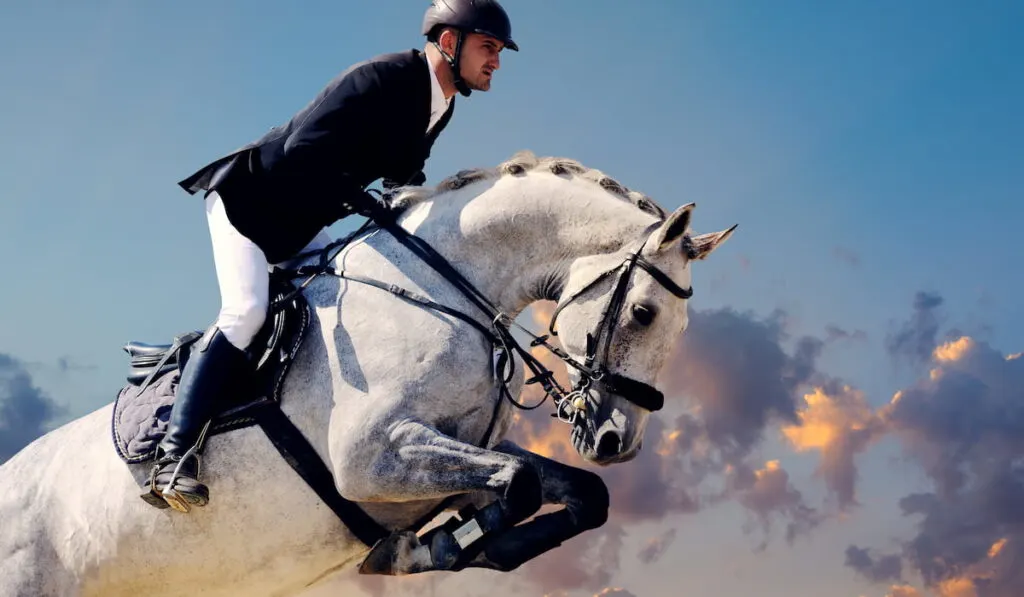Eventing – the impressive equestrian sport that fully tests a horse and rider’s stamina, athleticism, and talent. But what exactly is eventing, anyway? And how do all these confusing eventing levels work?
Hopefully, I can shed some light on the subject. If you’ve ever wanted to know a little bit more about this exciting sport and what it entails, keep reading to find my handy guide to the different levels of eventing.

Table of Contents
What is Eventing, anyway?
According to the United States Eventing Association, eventing is best described as an “equestrian triathlon.” Comprised of three phases, eventing is a sport that encompasses three separate equestrian events – dressage, cross-country, and show jumping (source).
Originally devised to test the skill and athleticism of the cavalry, eventing has evolved into an international sport that culminates in international tournaments and the Olympics Games.
Dressage

The first phase, dressage, tests a horse’s natural grace, athletic ability, and training. Dressage (which derives from the French word for training) is a display of horsemanship and skill from the rider, and obedience and willingness from the horse.
During the dressage portion of eventing, a horse and rider perform a series of specific movements that show off the horse’s athletic ability, training, and responsiveness. The difficulty and degree of complication of these movements are determined by the level of competition. The dressage portion of eventing is called a test, and the levels of difficulty are determined by the United States Dressage Federation (USDF). Eventing dressage tests follow the same patterns of USDF tests, so competitors know what to expect.
Cross-Country

The cornerstone phase of eventing, cross-country is a test of speed and endurance. Horse and rider pairs navigate a difficult jumping course through a countryside setting – with elevation changes and various kinds of natural obstacles.
The cross-country course is ridden at a gallop, and horses are asked to jump solid obstacles made of logs or brush, leap over wide ditches, navigate embankments, and clear (or jump into!) water obstacles. The height and difficulty of the jumps are dependent on the level of competition.
Show Jumping

In this phase, horse and rider teams must jump a clear round of tall obstacles in a set course pattern. This phase occurs after the cross-country phase, and is a test of a horse’s stamina and ability to recover.
The higher the level, the more difficult and complicated the course. Penalties are awarded for knocked rails and refusals, and a successful show jumping round can make or break a team’s score for the entire eventing competition.
A Basic Overview of Eventing
As with many equestrian disciplines, the amount of difficulty you can expect in competition and specific show requirements change according to the level you’re competing in. Eventing can be tricky to understand because it encompasses not one sport, but three.
Even the most seasoned eventing competitors have to be familiar with the extensive rulebook to make sure they’re well prepared for the obstacles they may face – and that they’re conditioned appropriately.
Here is a basic table that explains some of the differences between the levels of eventing competitions. For a more exhaustive breakdown, you can check out USEA’s website.
| Level | Dressage (USDF Comparable) | Cross-Country | Show Jumping |
| Beginner Novice | Training Level | Height: 2’7” Distance: 1400-2000m Speed: 300-350 mpm* Obstacles: 14-18 | Height:2’7” Speed: 300 mpm Obstacles: 9-11 |
| Novice | Training Level | Height: 2’11” Distance: 1600 – 2200m Speed: 350 – 400 mpm Obstacles: 16-20 | Height: 2’11” Speed: 320 mpm Obstacles: 9-11 |
| Training | First Level | Height: 3’3” Distance: 2000 – 2600m Speed: 420-470 mpm Obstacles: 20-24 | Height: 3’3” Speed: 325 mpm Obstacles: 10-13 |
| Modified | Training Level, First Level | Height: 3’5” Distance: 220 – 3000m Speed: 490 mpm Obstacles: 22-28 | Height: 3’5” Speed: 325 mpm Obstacles: 10-13 |
| Preliminary | First Level, Second Level | Height: 3’7” Distance: 2200 – 3120m Speed: 520 mpm Obstacles: 22-30 | Height: 3’7” Speed: 350 mpm Obstacles: 11-13 |
| Intermediate | Second Level | Height: 3’9” Distance: 2600 – 3575m Speed: 550 mpm Obstacles: 26-34 | Height: 3’11” Speed: 350 mpm Obstacles: 12-14 |
| Advanced | Third Level | Height: 3’11” Distance: 3200 – 3990m Speed: 570 mpm Obstacles: 32-40 | Height: 4’1” Speed: 375 mpm Obstacles: 13-15 |
*MPM is meters-per-minute. Basically, the speed at which a horse should be able to go from one obstacle to the next.Courses are timed, and horses that perform too slowly are penalized.
Dressage tests are also categorized by levels. For more information on the different dressage levels and what you’ll find on those tests, check out my post here.
Eventing dressage tests are often less complicated than competitive dressage tests, but they still require an incredible amount of skill from both the horse and the rider. For example, you will not see an eventing horse asked to perform the piaffe and passage of a Grand Prix Olympic test, but they still must perform dressage at a highly advanced level.

National Competition
There are different levels for national and international competitions, and they can also vary depending on which country you’re from. In the US, national competitions are categorized like this: Beginner Novice, Novice, Training, Modified, Preliminary, Intermediate, and Advanced.
Beginner Novice
This is the first level of eventing, designed to attract horses and riders who are new to the sport in a safe and friendly way. Events are available to riders of any age, horses over 4 years of age, and qualifying events are not necessary. However, horses should already be schooled at smaller sport-specific competitions to determine their readiness for eventing.
In the dressage phase, riders are asked to perform a dressage test that includes a good performance of a walk, trot, canter, 20m circles, and/or half-circles. In the cross-country round, there are 14 to 18 obstacles up to 2’7” in height (3’3” for brush fences). The course distance ranges from 1400 to 2000 m, and must be ridden at speeds between 300 to 350 mpm.
This certainly isn’t a leisurely pace, but it gives novice horses a chance to become accustomed to galloping through a course. Jumps in the show jumping round max out at 2’7”, and riders can expect 9 to 11 of these during a round.
Novice
Once horse and rider teams have competed in events at the Beginner Novice level and feel they are ready to move on to bigger and better things, the Novice Level is next. There are still no qualifying competitions necessary to compete, and horses must again be over age 4 (but riders can be any age).
The dressage test is similar to that in Beginner Novice, but may be more harshly scored or require slightly more difficult transitions. More obedience and training are required for this test, and it’s comparable to a USDF Training Level test.
In cross-country, obstacles are more difficult (bigger banks and water fences), and can reach 2’11” in height. There are between 16 and 20 obstacles, over a course distance of 1600 to 2200 meters. Horses are expected to achieve a speed of 350 to 400 mpm to successfully complete the cross-country portion.
The show jumping round includes jumps that reach 2’11”, and teams should expect 9 to 11 of those as well. The course speed is around 320 mpm.
Training
This is the last level of competition that doesn’t require qualifications to enter. Riders can still be any age to enter, and horses must still reach age 4 to compete.
The Dressage test includes movements from lower-level tests, but horses are also asked to lengthen the trot and canter, as well as perform 15m circles. These are slightly more advanced maneuvers in the dressage world, and the tests are comparable to USDF First Level tests.
The cross-country course must be ridden more quickly, at a speed of 420-470 mpm. Jumps reach a height of 3’3”, and competitors can expect 20 to 24 of them over a long distance of 2000 to 2600 meters. The show jumping round is bigger too – jumps also reach 3’3”, the speed hits 320 mpm, and there are between 10 and 12 obstacles to tackle.
Modified
Previously, the gap between the requirements of the Training and Preliminary levels was fairly large. To improve safety and increase participation, the USEA added the Modified level in 2017.
To qualify for the Modified level, riders must complete two MER’s (minimum eligibility requirements) at a Training Level or above. A rider earns an MER with no less than 50% good marks on the dressage test, a clear cross-country round, and no more than 16 penalties in the show jumping round.
Those competing at the modified level can expect a slightly more difficult dressage test than at the Training level. It will also include leg yielding and medium gaits.
In cross-country, the jumps reach 3’5”, the course extends between 2200 to 3000 meters, and must be ridden at around 490 mpm. Horses and riders must be ready to tackle between 22 and 28 difficult obstacles.
The show jumping round has a similar speed to the Training level, but the jumps are slightly higher at 3’5”, and there are 10-13 of them.
Preliminary
If competitors are serious about eventing, this is one of the higher levels of competition. Those who aim to compete internationally prepare with Preliminary events. Riders must be 14 or older and receive 4 MER’s at the Training level or above. Horses must be at least 5 years old.
The dressage test includes all of the basic movements of First Level dressage, and also serpentines, 10-meter circles, and backing. This test is comparable to a USDF First Level test, but adds some movements from Second Level tests as well. (source)
For cross-country, competitors can expect a course of 2200 to 3120 meters in length, with 22 to 30 obstacles reaching 3’7” in height. To be effective at this level, horses must achieve a blistering speed of 520 mpm. Show jumping courses reach 3’7” as well, and the 11 to 13 obstacles must be ridden at 350 mpm.
Intermediate
This level prepares riders for two-star international competitions. The technical difficulty increases at each level, but as the jumps get bigger – the stakes get higher. Riders must be 16 or older, horses must be 6 or older, and the qualifications become more strict.
Horse and rider teams must have 3 MERs at the Preliminary level, plus an additional MER at the Preliminary level with no more than 20 jumping penalties on the cross-country course. This is to ensure that both horse and rider can really handle the rigor of an intermediate course, safely.
For dressage, horses and riders must perform shoulder-ins, travers and renvers, and begin to show collection. This test is similar to what you’d see at the USDF Second Level.
The jumping rounds are fast, and the obstacles are high. In cross-country, 26 to 34 difficult obstacles reach 3’9”, the course distance is 2600 to 3575 meters, and it must be performed at a speed of 550 mpm. The 12-14 obstacles in the show jumping round are difficult to navigate (tight turns and tricky combinations), and reach 3’11” in height.
Advanced
This is the highest level of national eventing competition in the United States. These courses are designed to prepare competitors for the highest levels of international competitions – including the Olympics.
Riders must be 18 or older, and horses must be at least 6. Together, they must have 1 MER with no more than 20 jumping penalties on a cross-country course at an Intermediate event (or One Star event, or two Intermediate level events). Essentially, they need to be prepared and in peak physical condition – and prove it.
While the dressage test is never as difficult as say, an Olympic Grand Prix test, it still reaches the difficulty of a USDF Third Level test. Horses are expected to perform half-passes, flying changes, serpentines, and turn on the haunches. They are also asked to show collection and extension, which display an immense amount of training and obedience.
The cross-country course is difficult and long – 32 to 40 obstacles reach heights of 3’11”, and horses must speed around a course of 3200 to 3990 meters at 570 mpm. Show jumping obstacles reach 4’1”, and competitors must navigate 13-15 of them at 375 mpm.
International Eventing Competition
International FEI competitions are designated with stars: One Star, Two Stars, Three Stars, Four Stars, and Five Stars. The FEI changed the star rating system from 4 stars to 5 in 2019, in an effort to increase the safety of the sport and allow more countries to participate at the Olympic level.
Dressage tests at International competitions are comparable to USDF Third Level tests, and may include flying changes, travers, collected and extended gaits, and counter-canter. However, they cannot include Grand Prix level movements such as piaffe, canter pirouette, or passage. You’ll have to tune-in to dressage specific competitions for that.
In the US, riders must be prepared by scoring well in Preliminary, Intermediate, and Advanced competitions for entry into international starred events. Here is a basic breakdown of what you can expect in international eventing competitions:
| Star Level | Cross-Country | Show Jumping |
| One Star | Height: 1.05 m Distance: 2000-3000m Speed: 500 mpm Time: 4-6 minutes Obstacles: 20-25 | Height: 1.10 m Speed: 350 mpm Obstacles: 10-12 |
| Two Stars | Height: 1.10 m Distance: 2600 – 4680 m Speed: 520 mpm Time: 5-9 minutes Obstacles: 25-30 | Height: 1.15 m Speed: 350 mpm Obstacles: 10-13 |
| Three Stars | Height: 1.15 m Distance: 3000 – 5550 m Speed: 550 mpm Time: 5-10 minutes Obstacles: 27-35 | Height: 1.20 m Speed: 350 mpm Obstacles: 10-14 |
| Four Stars | Height: 1.15 m Distance: 3400 – 6270 m Speed: 570 mpm Time: 6-11 minutes Obstacles: 30-40 | Height: 1.25 m Speed: 375 mpm Obstacles: 11-15 |
| Five Stars | Height: 1.2 m Distance: 6270-6840 m Speed: 570 mpm Time: 11-12 minutes Obstacles: 40-45 | Height: 1.3 m Speed: 375 mpm Obstacles: 11-16 |
| Olympic Games | Height: 1.2 m Distance: 5600-5800 m Speed: 570 mpm Time: 9:50 – 1:10 minutes Obstacles: 38-42 | Height: 1.3 m Speed: 375 mpm Obstacles: 11-16 |
Eventing is a complicated and exciting sport. If you’re an equestrian enthusiast, watching a three-day eventing competition can be a good way to get a crash-course into the world of equine athletics.
Hopefully, this guide made you a little bit more familiar with the basic levels of eventing, and what to expect while watching an event. Happy eventing!

